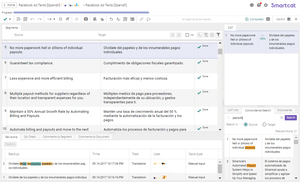Smartcat
Smartcat is a cloud-based translation platform that connects businesses, translators, and translation agencies in a single "Connected Translation" delivery loop (see also Connected Translation below).
 | |
Type of site | Computer-assisted translation, globalization management system, freelance marketplace, payment automation platform, legal automation platform |
|---|---|
| URL | www |
| Launched | July 2015 |
History
Smartcat was originally developed as a CAT tool in 2012–2015 as an in-house solution by ABBYY Language Solutions, a linguistic service provider within the ABBYY group of companies. The impetus for its development was that ABBYY LS had “felt constrained by translation technologies that had existed for the last 15 years” and wanted an "intuitive, cloud-based, scalable, and powerful" solution that would let them manage projects with dozens of collaborators, including project managers, translators, editors, and other professionals.”[1]
In 2016, Smartcat spun out of ABBYY LS to become a separate company and attracted $2.8 million in investments from Ilya Shirokov (ex-CEO at Odnoklassniki and founder of Yandex-acquired social network MoiKrug.ru).[2] ABBYY LS’s founder and CEO Ivan Smolnikov also left the company to fully focus on Smartcat.[3] The main reasons for the separation were that the "translation automation business turned out to be far from complementary to the services of language services providers" and that “some translation companies had been wary of using a service developed by a competitor.”[3]
As of January 2020, the platform has more than 250,000 freelancers in its marketplace[4] and provides an “app store” that allows users to integrate their Smartcat account with third-party tools.[5]
Although Smartcat has an in-built CAT tool that helps translators work faster and more efficiently, its reach and functionality are much broader than that of a CAT tool. It is an all-in-one translation platform connecting businesses and translation professionals while offering additional services like payment automation, a combination the company brands as “Connected Translation”. For example, it allows translation agencies and LSPs to manage their businesses, including everything from searching for new vendors to managing international teams and centralizing international payments.
Monetization and subscription plans
Unlike most industry tools, Smartcat does not charge for user-based licenses, because it believes that counting seats just doesn’t fit in the translation business, where more than 90% of users in companies are freelancers and a varying number of them collaborate on projects on a daily basis.”[1]
Instead, Smartcat’s monetization is primarily based on a percentage-based service fee charged on top of the rates of freelancers listed in and hired through the marketplace (freelancers set their own rates) or, if hiring companies from the LSP marketplace, a percentage of the order price. Apart from the Forever Free plan, Smartcat also offers paid subscription plans: Slim, Essential, and Smart.[6]
Connected Translation
In early 2019, Smartcat coined the new term and concept Connected Translation, positioning itself as an “all-in-one platform connecting businesses and translators into a streamlined content delivery loop”. The connected translation model is made up of five key concepts: connectivity, translation, scalability, management, and automated payments:
- Connectivity: interconnecting the content production and translation environments,
- Translation: actually executing the translation job,
- Scalability: sourcing new translation vendors if and when the need arises,
- Management: having control over the process by tracking progress, reassigning vendors, etc.
- Automated payments: sending bulk payments via a single invoice to any number of vendors in any location.
Document formats
Smartcat’s built-in CAT editor supports 70+ input formats, including text documents, presentations, spreadsheets, scanned documents and images (including a paid OCR service), HTML pages, resource files, industry-standard bilingual formats, and others.[7] The platform also supports SDL Trados packages, which allows users to work on projects originally intended for SDL Trados, including generation of return packages to be further handled in Trados[8].
External links
References
- "Why we don't count seats: On Licenses, Monkeys, and Cognitive Biases — The Smartcat Blog". The Smartcat Blog. 2017-04-05. Retrieved 2019-04-23.
- "Smartcat Raises USD 2.8m Seed Round From Russian VC → slator.com". 2016-07-20. Retrieved 2017-05-12.
- ""Interview with Ivan Smolnikov" → Roem.ru" (in Russian). 2017-03-20. Retrieved 2017-05-12.
- "Smartcat — Translation ecosystem that makes it easy for companies and talents to connect and collaborate".
- "Smartcat Store". www.smartcat.ai. Retrieved 2019-04-23.
- "Plans and Pricing Smartcat". www.smartcat.ai. Retrieved 2020-01-29.
- "File formats supported in Smartcat". Smartcat Help Center. Retrieved 2020-01-29.
- "Support for Trados packages in Smartcat". Translation & Localization Blog. 2018-08-15. Retrieved 2020-01-29.
- ""Free use" Model – a Risky Step for Startups". The Times of Israel. 14 February 2016.
- "ABBYY-LS' Smartcat Enters the CAT Race". Slator. 4 September 2015.
- "Life just got a whole lot easier for freelance translators". thenextweb.com. 1 September 2015.
- "In the land of a low-data language". TAUS. 31 March 2015.
- "Skolkovo resident ABBYY Language Services offers sophisticated translation automation technology for India". samacharvarta.com. 18 February 2015.
- "Digital India attracts Russian investors". Russoft. 13 February 2015.
- "Raising productivity of automated translation: The factor of terminology". TcWorld. 31 March 2014.